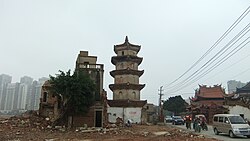Anhai
Anhai
| |
|---|---|
 Surviving White Pagoda (center) of Shuixin Chan Temple (right), with the adjacent old residential neighborhood (left) demolished, to make way for new development (such as seen in the background) | |
| Coordinates (Anhai town government): 24°43′00″N 118°28′34″E / 24.7166°N 118.4761°E | |
| Country | People's Republic of China |
| Province | Fujian |
| Prefecture-level city | Quanzhou |
| County-level city | Jinjiang |
| Time zone | UTC+8 (China Standard) |
| Anhai | |||||||||||||||||||||
|---|---|---|---|---|---|---|---|---|---|---|---|---|---|---|---|---|---|---|---|---|---|
| Chinese | |||||||||||||||||||||
| |||||||||||||||||||||
Anhai[a] is a town in southern Fujian province or Minnan, People's Republic of China. It is located in the far southern suburbs of the Quanzhou metropolitan area and is separated by Weitou Bay (simplified Chinese: 围头
The highest point in the town's administrative area is Mount Língyuán (simplified Chinese: 灵源
History
[edit]
Anhai was known as Anping (Chinese:
Anhai was an important port during the Ming and early Qing periods. The 19th-century researchers writing for the Hakluyt Society thought Anhai was the port of "Tansuso" visited by Martín de Rada, but later research identified Tansuso as Zhongzuosuo (Chinese:
Notes
[edit]- ^ Formerly romanized as Ganhai, Gan-hai,[citation needed] Nganhai.[2]
References
[edit]- ^ 厦门
大学 中国 语言文学 研究所 汉语方言 研究 室 , ed. (1982).普通 话闽南 方言 词典 [Dictionary of Putonghua and Min Nan Dialect] (in Chinese). Fuzhou: Fujian People's Publishing House. ISBN 962-04-0228-6. - ^ a b Chisholm, Hugh, ed. (1911), , Encyclopædia Britannica, vol. 6 (11th ed.), Cambridge University Press, p. 231
- ^ Chen, Boyi (
陳 博 翼 ) (December 2009). 「Aytiur」(Aytim)地名 釋 證 :附 論 早期 海 澄 的 對 菲貿易 [Identifying the place named "Aytiur" (Aytim), with a note on the early trade between Haicheng and Philippines] (PDF).明代 研究 [Ming Studies] (13): 81–108. Archived from the original (PDF) on 2011-08-22.

